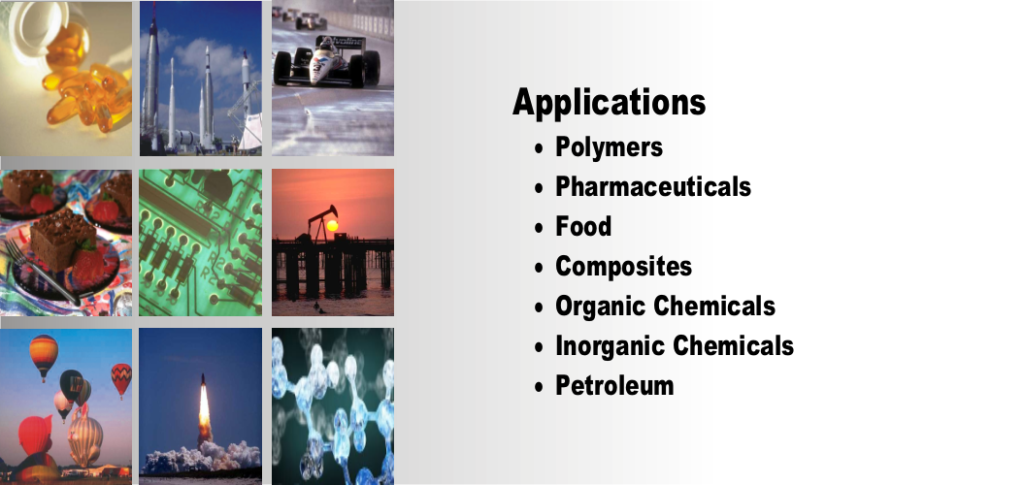Pharma Materials
DSC and TGA are often used for characterisation of pharma materials. DSC is able to differentiate between different polymorphic structures and, by using different heating rates, can investigate the transformations which occur during the polymorphic transformation. By using appropriate heating rates, polymorphic purity can be determined, and can involve heating rates up to 750°C/min. TGA is often used to measure residual solvents and moisture, but can also be used to determine solubility of pharma materials in solvents. Analysis of pharma materials is probably the largest area of application for thermal analysis.
Polymers
Polymers represent another large area in which thermal analysis finds strong applications. Thermoplastic polymers are commonly found in everyday packaging and household items, but for the analysis of the raw materials, effects of the many additive used (including stabilisers and colours) and fine-tuning of the moulding or extrusion processing used can be achieved by using DSC. An example is oxidation induction time (OIT) by DSC which can determine the amount of oxidation stabiliser present in a thermoplastic (usually a polyolefin) polymer material. Compositional analysis is often made using TGA, which can separate fillers, polymer resin and other additives. TGA can also give an indication of thermal stability and the effects of additives such as flame retardants
Thermal analysis of composite materials, such as carbon fibre composites or glass epoxy composites are often carried out using DMA which can measure the stiffness of materials by determining the modulus and damping (energy absorbing) properties of the material. Aerospace companies often employ these analysers in routine quality control to ensure that products being manufactured meet the required strength specifications. Formula 1 racing car manufacturers also have similar requirements! DSC is used to determine the curing properties of the resins used in composite materials, and can also confirm whether a resin can be cured and how much heat is evolved during that process. Application of predictive kinetics analysis can help to fine-tune manufacturing processes. Another example is that TGA can be used to measure the fibre content of composites by heating a sample to remove the resin by application of heat and then determining the mass remaining.
Metals
Production of many metals (cast iron, grey iron, ductile iron, compacted graphite iron, 3000 series aluminium alloys, copper alloys, silver, and complex steels) are aided by a production technique also referred to as thermal analysis. A sample of liquid metal is removed from the furnace or ladle and poured into a sample cup with a thermocouple embedded in it. The temperature is then monitored, and the phase diagram arrests (liquidus, eutectic, and solidus) are noted. From this information chemical composition based on the phase diagram can be calculated, or the crystalline structure of the cast sample can be estimated. Strictly speaking these measurements are cooling curves and a form of sample controlled thermal analysis whereby the cooling rate of the sample is dependent on the cup material (usually bonded sand) and sample volume which is normally a constant due to the use of standard sized sample cups.
Advanced techniques use differential curves to locate endothermic inflection points such as gas holes, and shrinkage, or exothermic phases such as carbides, beta crystals, inter crystalline copper, magnesium silicide, iron phosphide’s and other phases as they solidify. Detection limits seem to be around 0.01% to 0.03% of volume.
In addition, integration of the area between the zero curve and the first derivative is a measure of the specific heat of that part of the solidification which can lead to rough estimates of the percent volume of a phase. (Something has to be either known or assumed about the specific heat of the phase versus the overall specific heat.) In spite of this limitation, this method is better than estimates from two dimensional micro analysis, and a lot faster than chemical dissolution.
Foods
Most foods are subjected to variations in their temperature during production, transport, storage, preparation and consumption, e.g., pasteurization, sterilization, evaporation, cooking, freezing, chilling, etc. Temperature changes cause alterations in the physical and chemical properties of food components which influence the overall properties of the final product, e.g., taste, appearance, texture and stability. Chemical reactions such as hydrolysis, oxidation or reduction may be promoted, or physical changes, such as evaporation, melting, crystallization, aggregation or gelation may occur. A better understanding of the influence of temperature on the properties of foods enables food manufacturers to optimize processing conditions and improve product quality. It is therefore important for food scientists to have analytical techniques to monitor the changes that occur in foods when their temperature varies. These techniques are often grouped under the general heading of thermal analysis. In principle, most analytical techniques can be used, or easily adapted, to monitor the temperature-dependent properties of foods, e.g., spectroscopic (NMR, UV-visible, IR spectroscopy, fluorescence), scattering (light, X-rays, neutrons), physical (mass, density, rheology, heat capacity) etc. Nevertheless, at present the term thermal analysis is usually reserved for a narrow range of techniques that measure changes in the physical properties of foods with temperature (TG/DTG, DTA,DSC and Transition temperature).
Printed Circuit Boards (PCB)
Power dissipation is an important issue in present-day PCB design. Power dissipation will result in temperature difference and pose a thermal problem to a chip. In addition to the issue of reliability, excess heat will also negatively affect electrical performance and safety. The working temperature of an IC should therefore be kept below the maximum allowable limit of the worst case. In general, the temperatures of junction and ambient are 125 °C and 55 °C, respectively. The ever-shrinking chip size causes the heat to concentrate within a small area and leads to high power density. Furthermore, denser transistors gathering in a monolithic chip and higher operating frequency cause a worsening of the power dissipation. Removing the heat effectively becomes the critical issue to be resolved.


